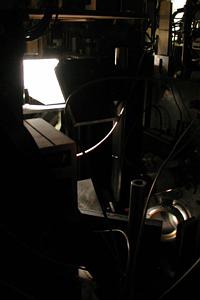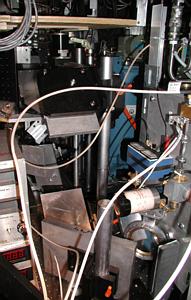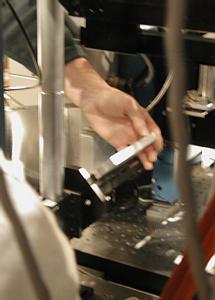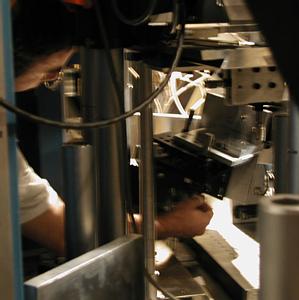
|
|
30 December, 2000
Aligning the Telescope
Now that the coldheads are completed, wešre able to get back to observing.
The skies have been unusually cloudy recently, so 230GHz is the frequency
of choice. The 230GHz receiver has not been used since last summer, and
while Ed Pernic and I were working on the coldheads, Chris Martin, Tony
Stark and Wilfred Walsh (next yearšs AST/RO winterover) were working
on tuning the 230GHz receiver so that we could begin observing again.
Unfortunately, sometime in the last year, probably earlier this summer
during the installation of PoleSTAR, the mirrors that direct the light
into the 230GHz dewar got misaligned. So, the project for today was to
align these mirrors so that light from the sky actually makes it into the
dewar.

The first step in this process was to see how far off we were. Since the skies today were clear, we pointed the telescope at the sun, turned off the lights in the receiver room, and could see a beam of sunlight reflected through the mirror system and onto the dewar. The sunlight struck the dewar very close to its window, so we were able to see that we were close to being aligned. However, this is a very crude method. We were able to see that we were not that far off, but not able to see where the system was misaligned.

In a normal telescope, unfiltered sunlight can be disastrous, since it concentrates the already bright sunlight to a small point. However, AST/ROs mirrors are designed to reflect wavelengths of light much longer than visible light, so the light from the sun was not optimally reflected, reducing the amount of light coming through the system. Although pointing directly at the sun without a filter is not something that we want to do all the time, it is possible to do with this telescope for proposes such as these. If AST/RO observes the sun for a long time, there is a solar filter, shown here, that is placed in the way of the beam, reducing the intensity of light. AST/ROs solar filter is a piece of cardboard holding a black garbage bag that is placed in the beam.

The next step is to see exactly which mirror in the system is off. There are a series of mirrors that brings the light from the dish on the roof into the receiver room, and then each dewar has a series of mirrors to reflect the light into that dewar. We began to find the misaligned mirror by assuming that it was one of the mirrors into the 230GHZ receiver, since we were able to observe with other receivers in the last few weeks. Instead of following the beam of light from the roof down, we went the other way, looking at the beam from the receiver to the roof. We can do this because the path that light travels through a series of mirrors is the same in either direction. This is a picture of the set of mirrors specific to the 230GHz receiver. The circular piece in the lower right is right in front of the window into the dewar. Tracing a light ray from the dewar, the first mirror we hit is just to the right of this circular piece. This mirror reflects the ray to another mirror that in this picture appears to be right on top of it, and from there the ray is reflected up to a mirror mounted above it, seen here on a black plate encircled by a cable. This mirror reflects the ray at about a 45 degree angle to another mirror which in this image is just to its right, and this mirror finally reflects the ray up to the sequence of mirrors shared by all four dewars which finally leads to the dish on the roof.

The receiver is designed to pick up low temperature signals. So, what we wanted to do was see where the receiver was pointed. To this end, we took a plastic paddle dipped in liquid nitrogen to cool it, and placed it in the path of the beam into the receiver. Looking at what the receiver sees, we should be able to see a cold temperature signal when the paddle is in the path of the beam. Here, Wilfred is holding the paddle in place while Tony reads the output. Based on the output, Wilfred moves the paddle to find exactly where the beam is.

It was finally determined that the misaligned mirror is probably the second from the dewar. Tony went to try to tweak the mirrors position, and realized that it was not locked in place- it was free to rotate. So, now that we have found the offending mirror, all we needed to do was to change its position slightly to correctly align the beam path.

The mirror was locked into position and two screws which control the precise left-right and up-down position of the mirror could be moved. The paddle was held in position on the opposite side of the dewar from the mirror while Wilfred adjusted these screws. By doing this, we could see if the beam was leaving this mirror in the proper direction to join the rest of the mirror system. After a few minutes of this, the mirror was aligned, and light from the sky could once again get to the receiver.
Contact the TEA in the field at
.
If you cannot connect through your browser, copy the
TEA's e-mail address in the "To:" line of
your favorite e-mail package.
|
